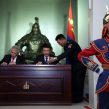
Mongolia Hosts Brief Visit From US Defense Secretary
Publication: Eurasia Daily Monitor Volume: 11 Issue: 75
By:

The last stop of US Secretary of Defense Chuck Hagel on his ten-day trip to Hawaii and Asia was to landlocked Mongolia. His short visit on April 10 featured charming photo-ops of his unique gift from the Mongolian government—a buff-colored horse that he named “Shamrock.” Although his position warranted this traditional gift from the Mongolian perspective, this honor, presented in the auspicious Year of the Horse, was ripe with symbolism not lost on the Mongolian public or the greater Asian community. The Mongolian media’s portrayal of Secretary Hagel’s stopover revealed how Mongolia utilized the visit to send its own message domestically and to its neighbors, especially China and Russia, that Mongolia is assuming an active voice in regional affairs and that the United States is signaling its acceptance of such a role.
Such concepts were illustrated in Secretary Hagel’s meeting with Mongolian Prime Minister Norov Altankhuyag, where Altankhuyag emphasized that the Mongolian government will continue to further expand defense cooperation with the US (The Mongol Messenger, April 11) by supporting “an implementation of master goals of the Mongolia-USA defense collaboration” (montsame.gov.mn, April 10). The Mongolian message was repeated again by Minister of Defense Dashdemberel Bat-Erdene in a joint news conference where he explained that the visit has lifted bilateral cooperation “to a new volume,” and that “Mongolia is adhering to a policy to take part in international activities as much as possible instead of passively observing them” (montsame.gov.mn, April 10).
The fact that Hagel spent only four hours in Mongolia compared to three days in China was not mentioned in the Mongolian press. Rather, media outlets stated that the United States wanted increased defense and military ties with Mongolia because this friendly cooperation was part of the US policy of rebalance (pivot) in the Asia-Pacific region (UB Post, April 11). Hagel’s meetings with Mongolian government and military leaders were “to discuss regional security matters and ways to enhance future U.S.-Mongolian cooperation” (The Mongol Messenger, April 11). Domestic reporting did not connect the visit to the Russian-Ukrainian situation, even though this issue was raised at the joint press conference. Russian actions in Ukraine are a sensitive issue for Mongolia, so the government has been publicly silent about the Russian takeover of Crimea and has abstained from the United Nations vote to condemn Russia. It likely was not coincidental that on the same day as the Hagel visit there was a consultative Vice Ministerial meeting in Moscow between the foreign ministries of Mongolia and the Russian Federation to discuss details for high-level bilateral visits to celebrate this year’s 75th anniversary of the Mongolian-Soviet victory over Japan at Khalkhin Gol in eastern Mongolia and other regional and border cooperation matters (montsame.gov.mn, April 11).
Secretary Hagel briefed his Mongolian hosts on the discussions that had taken place with Japan and especially China. From the US point of view, the main “deliverable” from the visit was the signing in Ulaanbaatar by the Secretary and Minister Bat-Erdene of a “joint vision” statement calling for expanding military cooperation through joint training and assistance with no specific linkages to regional issues. Hegel simply explained that the joint statement “expresses our shared desire to continue deepening that defense relationship.” While the document can be seen as mostly symbolic, Beijing in the past has accused Washington of trying to counter its rise by cultivating military ties with smaller Asian neighbors (channelnewsasia.com April 10). Significantly, the official distribution of the joint statement by the two governments has been noticeably different. The Mongolian Ministry of Defense’s website posted the Mongol-language version of the text on April 12 (mod.gov.mn), but as of April 17, the English version had not been published on the US Embassy’s and Department of Defense’s websites.
Mongolia’s military relationship with the United States has greatly developed over the past fifteen years. Mongolian soldiers have deployed on ten rotations to Iraq and Afghanistan, and the US has been instrumental in modernizing Mongolia’s forces for UN peacekeeping operations worldwide. The Defense Department provides the Mongolian Armed Forces with $1 million annually in International Military Education and Training and $2 million annually in Foreign Military Financing funds for vehicles and communications equipment. The Mongolian military is seeking more sophisticated equipment and even planes, possibly available after the US drawdown in Afghanistan. Even more importantly, the two nations are attempting to define a post-Afghanistan relationship to develop new forms of cooperation in many areas including military medical service (https://www.defense.gov/news/newsarticle.aspx?id=122044).
Mongolian authorities do not want to jeopardize their solid relationship with Russia over events in Ukraine, but ramifications from Russian actions are rippling back into Northeast Asia to threaten what were considered settled borders. The Mongolian government and public have become concerned about recent loud chatter on Chinese websites calling for Beijing’s rejection of the 1945 UN plebiscite that recognized formal Mongolian independence from the Republic of China and urging the re-incorporation of Mongolia. When directly questioned at the joint press conference with Hagel, the Mongolian minister of defense, well aware of potential severe negative reaction from China and Russia, clearly indicated that the establishment of US bases in Mongolia would not be permitted for now: “We have a law not to establish foreign military bases or to station troops in our country” (channelnewsasia.com, April 10). For some reason, Bat-Erdene’s carefully-worded reply is omitted in the Defense Department website’s English version of the press conference transcript, but this statement was prominently featured in Mongolian, including English-language, press accounts. Nonetheless, Mongolian media highlighted the fact that the Ulaanbaatar bilateral discussions were friendly and positive as compared to the harsh tone of Hagel’s meetings with the Chinese. It also is apparent that Hagel’s references to Mongolia as “a valued partner” and “a growing state in regional and global security” (https://www.defense.gov/news/newsarticle.aspx?id=122044) were viewed by Mongolians and many others in the region as US affirmation of Mongolia’s growing importance in Asian security affairs.




